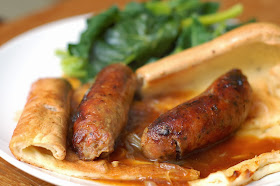Amok is widely seen as the national dish of Cambodia. It is a fragrant spiced curry that is steamed in banana leaves or coconut shells. You can get fish (trey), prawn, chicken and vegetarian versions but the fish is the most traditional. The flavour is similar to a mild Thai red-curry and there is a similar dish in Thailand called Hor Mok.
To make your own amok at home is actually surprisingly easy. If you really don't have the time to make your own paste from scratch by all means use a ready bought red curry paste but get the best one you can find. Thank you to Mimi Aye and Luke Nguyen for their inspiration putting together this version of Amok trey.
Ingredients (serves 2-4 depending on serving bowl size)
Amok Paste:
3 long dried chillies, cut finely and soaked for around 30 minutes in tepid water to soften6 large cloves garlic
2 shallots finely diced
4cm piece/s fresh turmeric root or 1 tsp ground turmeric
4 sticks of lemongrass, trimmed and sliced as finely as possible
thumb sized piece of galangal, peeled and finely diced
thumb sized piece of ginger, peeled and finely diced
6 kaffir lime leaves, finely sliced
1 tbsp Thai shrimp paste
Everything else:
400ml (1 can) coconut milk
2 eggs
handful of large spinach leaves or similar
2 kaffir lime leaves
1 tbsp palm sugar
1 tbsp fish sauce
approx 400g firm fish fillets, cut into bite sized pieces (or the equivalent of chicken, prawns, squid etc.)
1 tbsp vegetable oil
 |
| finished paste |
- Start of by making the paste. You can either do this in a food processor or you can use a pestle and mortar. Either way, make sure everything is cut as finely as possible before you start and it will make the whole process a lot quicker and easier. If you're using the pestle and mortar start off with the 'harder' ingredients then add everything else little by little. I started with the lemongrass then galangal, ginger, turmeric root, soaked chillies, lime leaves, garlic, shallot then finally the shrimp paste.
- Heat the oil in a pan then cook the amok paste until fragrant (1 minute or so) then add the coconut milk and simmer gently for around 5 minutes. Season with the fish sauce and pam sugar then remove from the heat and set aside to cool a little.
- Now prepare your steamer. I used a metal trivet in the bottom of a large saucepan. Place the pan over a medium heat and bring the water up to a boil. If you have the time, patience and materials now would be a good time to make your banana leaf cups too. Check out Rachel Cooks Thai for a good tutorial. I was hungry and couldn't find any banana leaves when I went shopping so instead used my oversized tea cups. They worked perfectly.
- Once your coconut mixture has cooled enough stir through the beaten eggs and add the fish chunks. Line your bowls/tea cups/banana leaf bowls with the spinach leaves then spoon in the fish pieces. Pour over most of the liquid but leave a little to one side for later.
- Now place your filled bowls in the steamer, cover and steam on a high heat for 15 minutes. Add the remaining liquid to the bowls then lower the heat to medium and cook for a further 30 minutes. During the cooking process the amok will souffle up a little so don't be alarmed.
- Once the time is up, remove the bowls from the steamer. Drizzle over a little coconut milk and garnish with some sliced kaffir lime leaves and finely sliced chillies too if you like. Serve with steamed rice.























